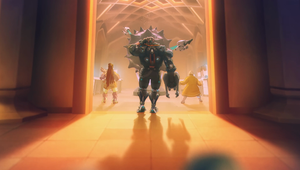
The Reality Complex: Creating for an Augmented World

In part one of the Reality Complex, We Are Royale's Loren Judah introduced the idea of an alternate reality layered over our own. This world is not some idealistic imagination brought forth by a single visionary, but instead a mixed reality (MR) projection of our online world. In part two, he takes a deeper dive into what those creative executions may look like and how location persistency might enable the next great land rush in mixed reality.
Augmented reality (AR) tech has introduced us to the very real future where virtual people, places, and things can exist in the world around us. Currently, the tech is limited to a handheld device such as your smartphone but the real magic kicks in when we make the leap from handheld to wearable. With it comes a shift in our perspective and creative approach. We make the leap to mixed reality (MR) when new technology can visually scan and understand your place in the physical world. The addition of computer vision technology and environmental data-collection enables virtual content to understand its own place in our physical world. Everything from a product installation at a store to emergency directions will become spatially aware of our world.
A great example of a familiar MR experience would be maps. On your phone or tablet, they show you roads, transit lines, traffic, and even local shops and ratings according to society (random people). This is a contextual layer that we’ve gotten used to consulting frequently. Before fancy phones or tablets, folding paper maps also provided this contextual layer over our world, though disconnected and far less convenient. With AR and MR technology we take this layer and place it out in front of us as we move about the world. All of that information will be visible and perceived the same as the practical objects that are physically there.

When we look through our screens into the world around us, the possibilities for MR content become endless. Stores will place MR ads right in their windows custom tailored just to you. Video feeds will become portals we will step into for an immersive 360 look all over the world. Even city parks will host art and events built entirely for a mixed reality audience. With our heads held high, we might just experience the world with fresh new eyes! There is a trade-off here though. Much like the challenge of self-driving cars, we need to be aware of distracted people failing to notice the real dangers around them. Musk might need to create a self-walking human. With this virtual layer affixed with us at all times, we move about the world in a bubble of our own simulacrum.
Virtual content could mimic elements of our physical world or they could evolve into more fluid experiences. Narrative content can now exist in the world and create personalised moments for each and every viewer. For instance, an athletic company could design personalised running routes complete with a digital path or virtual running partner to follow, all projected out into the world in MR. Museums have already begun to explore AR content and contextual information paired with exhibits and famous pieces. Imagine an architectural tool that lets designers experience their future space then adjust a few walls by reaching out and pushing them. News feeds will deliver relevant articles based on your preferences, current location, time of day, and even what you are looking at. Our future offices may transform into open tables devoid of screens, letting work content live in the MR view of the individual employee. The built environment will come to life as a sub-reality telemetric membrane visualised all around you.
Location persistency will introduce an ability to place a virtual object in a location and have it remain there not just for you, but everyone else as well. This era of location persistent MR will inspire us to treat virtual content much like physical content. We may hold it, take it with us, and even have places around the home where we like to keep it. The persistent locations where that virtual content can exist may be controlled and sold much like a website domain or physical property. Just imagine: you own your house, the land it sits on, and the mixed reality space it shares.
We may be looking at a virtual land rush similar to the .com boom. DNS hosting services may offer GPS zones where buying the virtual GPS coordinates gives you ownership of the corresponding world area in MR. The question is; will we create content for a unified network much like the internet today or will every company strive to create their own version of this MR world?
Creating for this future is exciting and will require a mindful approach. Our future content will be cerebral, immersive, and designed entirely for us. The responsibility of creators is going to be in the content we create that lifts people up and out of their bubbles rather than cocooning them into a false reality of their own making.















